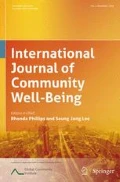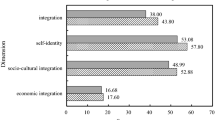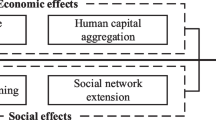Abstract
Migration intention of residents has become an important issue for the local governments as they have been experiencing an exodus of the residents to other regions topped with the country’s low birthrate that naturally results in the population decrease. Hence, this study explores the determinants of migration intention of residents in South Korea (hereafter Korea), with special focus on the social relationship within the community. In detail, this study attempts to prove if the two aspects of the social relations within the community - local social capital and individual subjective socioeconomic status - have an effect on the migration intention. Furthermore, the study has been conducted by separating urban and rural areas. The results of the analysis reveal that individual subjective SES had a greater influence in rural areas, whereas, it was the local social capital in urban areas. This result can be explained by the difference of the ‘individual anonymity’ between urban and rural areas. In rural areas, where the anonymity of individuals is relatively low due to the active interactions between neighbors, the influence of individual subjective socioeconomic status can have a great effect. On the other hand, in urban areas, where the anonymity of individual is relatively high, the influence of local social capital may have a greater effect on migration intention.

Similar content being viewed by others
References
Bourdieu, P. (1986). The forms of capital. In J. Richardson (ed), (trans: Nice R.), Handbook of theory and research for sociology of education (pp. 46–58) New York: Greenwood.
Coleman, J. S. (1998). Social capital in the creation of human capital. American Journal of Sociology, 94, S95–S120.
De Silva, M. J., McKenzie, K., Harpham, T., & Huttly, S. R. (2005). Social capital and mental illness: A systematic review. Journal of Epidemiology & Community Health, 59(8), 619–627.
Gu, Y. Y., & Park, I. K. (2015). The relationship between immigrant social capital and community adaptation. Urban Administration, 28(4), 53–76.
Heaton, T., Fredrickson, C., Fuguitt, G. V., & Zuiches, J. J. (1979). Residential preferences, community satisfaction, and the intention to move. Demography, 16(4), 565–573.
Hong, S. H., & Yoo, S. Y. (2012). Determinants of interregional migration by age cohort among Korean cities, counties or wards. Seoul City Studies, 13(1), 1–19.
Jaccard, J., Wan, C. K., & Turrisi, R. (1990). The detection and interpretation of interaction effects between continuous variables in multiple regression. Multivariate Behavioral Research, 25(4), 467–478.
Kan, S. H., & Kim, Y. (1981). Religious affiliation and migration intentions in nonmetropolitan Utah. Rural Sociology, 46(4), 669.
Kim, H. Y. (2010). Community inequalities in health : The contextual effect of social capital. Korean Journal of Sociology, 44(2), 59–92.
Kim, K. W., & Shin, D. H. (2017). The effect of social capital and socio - economic status on the subjective well - being of middle - aged men and women in rural areas. Rural Society, 27(2), 137–172.
Kim, S. L., & Yoo, P. J. (2017). The relationship between perceived subjective socioeconomic status and physical health among late school-aged children – A psychosocial perspective. Korean Child Welfare, 57, 43–82.
La Due Lake, R., & Huckfeldt, R. (1998). Social capital, social networks, and political participation. Political Psychology, 19(3), 567–584.
Lang, R. E., & Hornburg, S. P. (1998). What is social capital and why is it important to public policy? Housing Policy Debate, 9(1), 1–16.
Lansing, J., & Mueller, E. (1967). The geographic mobility of labor.
Lee, J. Y. (2006). Community and social capital (pp. 23–49). Korea Society of Social Sciences Symposium.
Lee, J. K. (2009). Satisfaction with life and social capital: Centered on the effect of civic participation, trust and social resources. Studies in Humanities and Social Sciences, (22), 5–40.
Lee, Y. W. (2013). An exploratory study on regional identity and social capital composition. Korean Journal of Journalism & Communication Studies, 57(6), 636–662.
Lee, S. Y. (2016). Rehabilitation plan of local government in response to local disappearance. Urban Problems, 51(577), 24–27.
Lee, Y. K. (2018). The relationship between local governments’ policy orientation and population movement: Exploring the possibility of local governments’ redistribution policy. Journal of Korean Public Administration., 52(2), 301–335.
Lim, S. L., & Jung, S. H. (2017). The effect of urban to rural migrants’ social capital on the development of rural areas. Korean Resional Sociology, 18(1), 79–99.
Lu, N., Jiang, N., Lou, V. W., Zeng, Y., & Liu, M. (2017). Does gender moderate the relationship between social capital and life satisfaction? Evidence from urban China. Research on Aging, 1–22.
McGinnis, R. (1968). A stochastic model of social mobility. American Sociological Review, 712–722.
Oh, J.-H. (2003). Social bonds and the migration intentions of elderly urban residents: The mediating effect of residential satisfaction. Population Research and Policy Review, 22(2), 127–146.
Portes, A. (1998). Social capital: Its origins and applications in modern sociology. Annual Review of Sociology, 24(1), 1–24.
Putnam, R. D. (2000). Bowling alone: America’s declining social capital. In Culture and politics (pp. 223–234). Springer.
Rohe, W. M., & Stewart, L. S. (1996). Homeownership and neighborhood stability. Housing Policy Debate, 7(1), 37–81.
Rossi, P. H. (1955). Why families move: A study in the social psychology of urban residential mobility. Free Press.
Singh-Manoux, A., Adler, N. E., & Marmot, M. G. (2003). Subjective social status: Its determinants and its association with measures of ill-health in the Whitehall II study. Social Science & Medicine, 56(6), 1321–1333.
Speare, A. (1974). Residential satisfaction as an intervening variable in residential mobility. Demography, 11(2), 173–188.
Speare, A., Jr., Kobrin, F., & Kingkade, W. (1982). The influence of socioeconomic bonds and satisfaction on interstate migration. Social Forces, 61(2), 551–574.
Ulrich-Schad, J. D., Henly, M., & Safford, T. G. (2013). The role of community assessments, place, and the great recession in the migration intentions of rural Americans. Rural Sociology, 78(3), 371–398.
Von Reichert, C. (2006). Community evaluation and migration intentions. In Population change and rural society (pp. 333–356). Springer.
Winkler, R., Cheng, C., & Golding, S. (2012). Boom or bust? Population dynamics in natural resource-dependent counties. In International handbook of rural demography (pp. 349–367). Springer.
Wolpert, J. (1965). Behavioral aspects of the decision to migrate. Papers in Regional Science, 15(1), 159–169.
Yoon, S. H., & Han, S. W. (2018). Possible reduction of productive population and potential for local autonomous entrenchment. KRI report issue analysis, 18–21.
Acknowledgements
This paper was supported by the Ministry of Education of the Republic of Korea and the National Research Foundation of Korea (NRF-2016S1A3A2924563).
Author information
Authors and Affiliations
Corresponding author
Additional information
Publisher’s Note
Springer Nature remains neutral with regard to jurisdictional claims in published maps and institutional affiliations.
Rights and permissions
About this article
Cite this article
Lee, Y., Lee, S.J. Analysis of the Influence of Social Relations on Migration Intention: Focusing on Local Social Capital and Subjective Socioeconomic Status. Int. Journal of Com. WB 2, 193–211 (2019). https://doi.org/10.1007/s42413-019-00035-9
Received:
Accepted:
Published:
Issue Date:
DOI: https://doi.org/10.1007/s42413-019-00035-9




